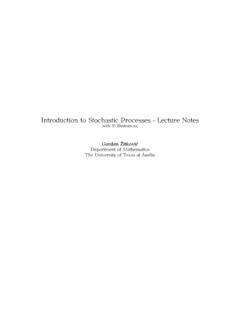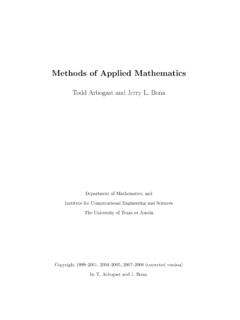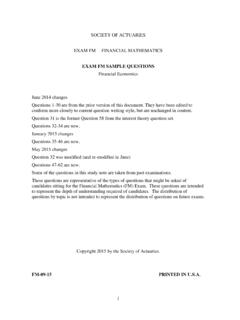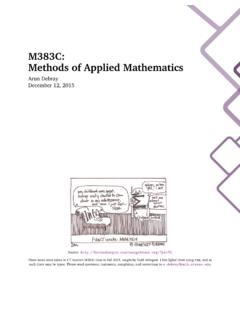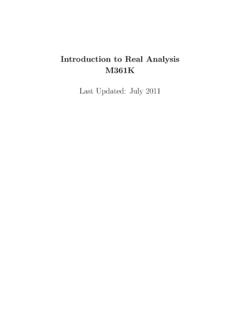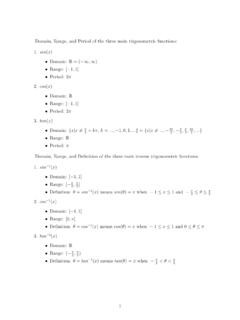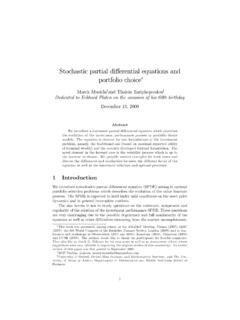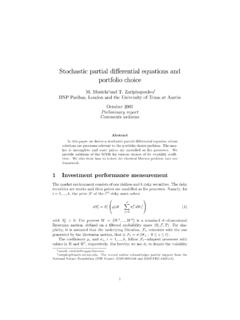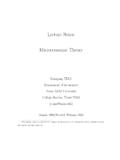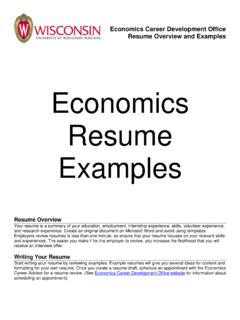Transcription of INTRODUCTION TO FINANCIAL ECONOMICS
1 INTRODUCTION TO FINANCIAL ECONOMICSG ordan Zitkovi cDepartment of MathematicsUniversity of Texas at AustinSummer School in Mathematical Finance, July-August 2009 This version: July 28, 2009 GORDAN ZITKOVI CINTRODUCTION TO FINANCIAL ECONOMICSFINANCIAL ECONOMICSIT hese lectures are about an oversimplified view that many math-ematicians have of FINANCIAL name of the game is transfer of wealth either in time or acrossstates of the you spend$95on a bond which pays$100in a yearfrom now, you have effectively exchanged (transferred) a share of a stock of a publicly traded food com-pany which is currently trading at$100and you know that the price of thesame stock in a year from now will fall (say to$80) if there is a drought,and rise (say to$110) otherwise.
2 In a simplified world where only two pos-sible futures can arise (droughtandno drought), this stock allows you totransfer 100today-dollarsinto an uncertain amount of money, which canbe described ZITKOVI CINTRODUCTION TO FINANCIAL ECONOMICSFINANCIAL ECONOMICSIThe useful thing - and this is the central service the FINANCIAL sec-tion provides - is that you can also do exactly the opposite: youcan get$95right now in exchange for a future payment of$ is how you can afford to buy a car and enjoy it now (or ahouse, but let s not go there) and use your future income to payfor , you could short-sell the stock, , get$100today fora promise to pay either$80or$110in a year from now, contingenton the state of the world (drought or no drought).
3 IThe main purpose of these lectures is to describe a mathemat-ical formalism built precisely with the purpose of understandingvarious ways wealth can be ZITKOVI CINTRODUCTION TO FINANCIAL ECONOMICSFINANCIALECONOMICSIThe goal here is to cover only the minimum amount of material fora student to be able to go on and learn about the basic notions ofmathematical finance in a subsequent course, we keep our mod-els as simple as possible. A single consumption good is positedand the future is multi-period but finite. Similarly, there is only afinite number of states of the , we work exclusively in a finite-dimensional Eu-clidean space, but we interpret its elements in different ways andgive them different names, depending on the role they play.
4 Thisway, we keep conceptually different but formally equivalent ob-jects separated and we pave the way to the infinite-dimensionalcase, where vectors come in many flavors and ZITKOVI CINTRODUCTION TO FINANCIAL ECONOMICSTHE WORLDIWe model the world as a tree-like structure that describes thepossible ways the future can are two qualitatively different dimensions in which wealthcan be transferred - through time and through the set of time instances, we takeT={0,1,..,T}, for someT uncertainty is modeled by a nonempty finite set which wecalls the set of states of the become interesting when we start to incorporate the factthat we learn more and more about the true state of the world astime marches on, , when we model the gradual resolution ZITKOVI CINTRODUCTION TO FINANCIAL familyFof subsets of is called analgebraif1.
5 F, FthenAc F, ,B FthenA B notion you are going to hear about more often is a -algebra is a generalization of the concept of an algebra whichis useful only if the number of states of the world is infinite. Other-wise, the two concepts coincide, so we have absolutely no reasonto complicate our lives with the extra .GORDAN ZITKOVI CINTRODUCTION TO FINANCIAL ECONOMICSALGEBRA= INFORMATIONIYou can picture information as the ability to answer questions(more information gives you a better score on the test .. ), andthe lack of information as our world, all the questions can be phrased in terms of the ele-ments of the state-space.
6 Remember - contains all the possi-ble futures of our world and the knowledge of the exact (the true state of the world ) amounts to the knowledge of , the ultimate question would be What is the true ? , and theability to answer that would promote you immediately to the levelof a Supreme Being. In order for our theory to be of any use tous mortals, we have to allow for some ignorance, and considerquestions like Is the true an element ofA? ,(1)whereAis a subset of .GORDAN ZITKOVI CINTRODUCTION TO FINANCIAL ECONOMICSALGEBRA= INFORMATIONIIIThe state of our knowledge can be described by the set of allquestions you know the answer to.
7 Since all questions about thetrue state of the world can be phrased as questions about sets ofstates, the proper mathematical description of our current knowl-edge is nothing but the collection of all thoseAfor which we knowthe answer to (1).IThe nice thing about that set is that - for purely logical reasons -it has lots of structure. You are probably already guessing that Iam talking about the fact that set - let us call itF- has to be analgebra. Let s see why:GORDAN ZITKOVI CINTRODUCTION TO FINANCIAL ECONOMICSALGEBRA= INFORMATIONIIIIF irst of all, I always know that the true is an element of , so , if I happen to know how to answer the questionIs the true inA?
8 , I will necessarily also know how to answer the question Is the true inAc? . The second answer is just the opposite ofthe first. Equivalently,A FimpliesAc , letAandBbe two sets with the property that I know howto answer the questions Is the true inA? and Is the true inB? . Then I clearly know that the answer to the question Isthe true inA B? is No if I answered No to each of thetwo questions above. One the other hand, it is going to be Yes if I answered Yes to at least one of them. ThereforeA,B FimpliesA B ZITKOVI CINTRODUCTION TO FINANCIAL ECONOMICSALGEBRA= PARTITIONIAs we shall see in the following problem, the seemingly compli-cated notion of an algebra is really equivalent to the simpler notionof a partition of a set is a familyPof non-empty sub-sets of such thatA B= wheneverA6=Band A PA=.
9 IProblem be a nonempty finite set, and letAbe the family of allalgebras on , and let be the family of all partitions of . Construct amappingF: Aas follows: for a partitionP={A1,A2,..,Ak}of ,letF(P) =Abe the family consisting of the empty set and all possibleunions of elements that so defined familyAis an algebra, that the mappingFis one-to-one and ZITKOVI CINTRODUCTION TO FINANCIAL ECONOMICSALGEBRA= PARTITIONIIIP roblem 2.[Just for fun, not important for the sequel]Forn N, letanbe the number of different algebras on when hasexactlynelements. Show ,a2=2,a3=5, and that the following recursion holdsan+1=nXk=0 nk!ak,wherea0=1by definition, exponential generating function for the sequence{an}n Nisf(x) =eex 1, , that Xn=0anxnn!
10 =eex ZITKOVI CINTRODUCTION TO FINANCIAL ECONOMICSAMODELING EXAMPLEIT hree candidates (let call them Candidate 1, Candidate 2 and Candidate3) participate in a presidential election; Candidates 1 and 2 are womenand Candidate 3 is a man. Since we are only interested in the winner ofthe election, we model the possible states of the world by the elementsof the set ={ 1, 2, 3}where, as expected, imeans that Candidateiwins the wake up on the day following the election without knowing how theelection went; we do know that there one of the candidates has beenelected, but that is all. Our knowledge can be modeled by the algebraA0={ , },or, equivalently the trivial partitionP0={ },as the only questions we know how to answer are Is the new presidenteither Candidate 1, Candidate 2 and Candidate 3?
